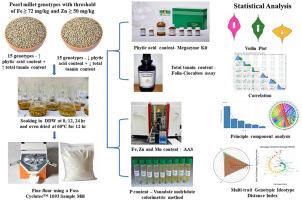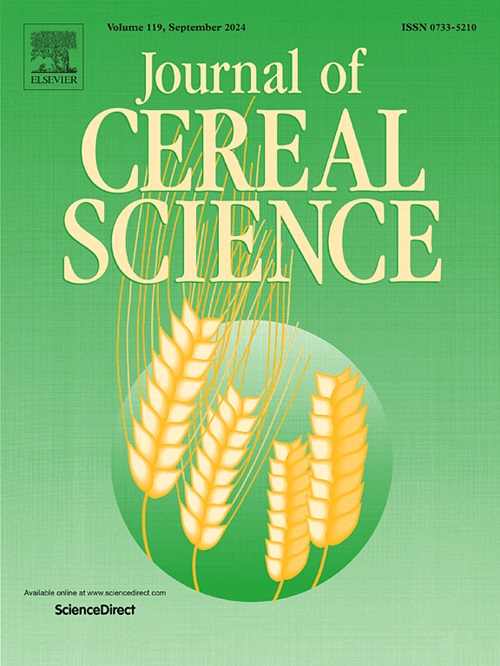珍珠粟营养动态:种子浸泡对矿物质和抗营养素含量的影响
IF 3.7
2区 农林科学
Q2 FOOD SCIENCE & TECHNOLOGY
引用次数: 0
摘要
珍珠粟营养丰富,但矿物质的生物利用度受到单宁和植酸等抗营养因素的限制。本研究评估了30个基因型的种子浸泡(0,12和24 h)。浸泡显著降低植酸和单宁,提高矿物质的生物利用度。但造成养分淋失,磷(5731.38 ~ 1006.83 mg/kg)、锌(69.21 ~ 50.37 mg/kg)、铁(116.42 ~ 93.12 mg/kg)、锰(17.91 ~ 13.93 mg/kg)下降。关联分析表明浸泡12 h平衡了营养保留和抗营养减少。主成分分析(65.9%的变异)确定植酸、单宁、锌和磷是主要贡献者。多性状选择指标表明G19、G22和G23最适合提高生物利用度。G29的单宁还原率最高(89.17%),而G23的植酸还原率最高(87.77%)。这些结果表明,种子浸泡在降低珍珠粟抗营养成分和提高矿物质生物利用度方面的有效性。本文章由计算机程序翻译,如有差异,请以英文原文为准。

Nutrient dynamics in pearl millet: Impact of seed soaking on minerals and anti-nutrient contents
Pearl millet is nutrient-rich, but mineral bioavailability is limited by anti-nutritional factors like tannins and phytic acid. This study assessed seed soaking (0, 12, and 24 h) in 30 genotypes. Soaking significantly reduced phytic acid and tannins, enhancing mineral bioavailability. However, it caused nutrient leaching, decreasing phosphorus (5731.38–1006.83 mg/kg), zinc (69.21–50.37 mg/kg), iron (116.42–93.12 mg/kg), and manganese (17.91–13.93 mg/kg). Association analysis suggested 12 h soaking balanced nutrient retention and anti-nutrient reduction. Principal component analysis (65.9 % variation) identified phytic acid, tannins, zinc, and phosphorus as key contributors. Multi-trait selection indices identified G19, G22, and G23 as most suitable for enhancing bioavailability. G29 had the highest tannin reduction (89.17 %), while G23 showed the greatest phytic acid decrease (87.77 %). These findings highlighted the effectiveness of seed soaking in reducing anti-nutrients and enhancing mineral bioavailability in pearl millet.
求助全文
通过发布文献求助,成功后即可免费获取论文全文。
去求助
来源期刊

Journal of Cereal Science
工程技术-食品科技
CiteScore
7.80
自引率
2.60%
发文量
163
审稿时长
38 days
期刊介绍:
The Journal of Cereal Science was established in 1983 to provide an International forum for the publication of original research papers of high standing covering all aspects of cereal science related to the functional and nutritional quality of cereal grains (true cereals - members of the Poaceae family and starchy pseudocereals - members of the Amaranthaceae, Chenopodiaceae and Polygonaceae families) and their products, in relation to the cereals used. The journal also publishes concise and critical review articles appraising the status and future directions of specific areas of cereal science and short communications that present news of important advances in research. The journal aims at topicality and at providing comprehensive coverage of progress in the field.
 求助内容:
求助内容: 应助结果提醒方式:
应助结果提醒方式:


